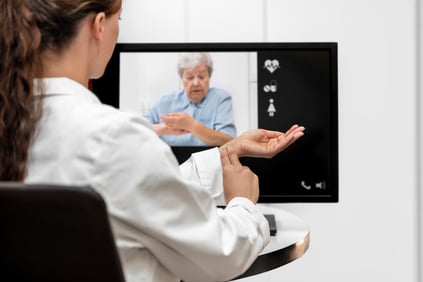Telemedicine is one of the emerging healthcare technologies that is revolutionizing our routines and lifestyles. Its mission? Don't make a physical check-up necessary. But telemedicine is not only about sending a picture of your wound on WhatsApp to your doctor. Its main innovative branches include: tele-consultation, telemonitoring, telecardiology (remote diagnosis), but also teleradiology (expert consultation) and telelearning.

An interesting example is Cognihub, an Indian organization that uses virtual reality to treat patients affected by different disorders, including pre/post-chemo cancer rehabilitation. They have demonstrated that remote care helps reduce anxiety, pain perception, and the assumption of opioids.
Indeed, the remote healthcare market is rapidly growing. According to forecasts, it is expected to rise from $79.79 billion in 2020 to $396.76 billion in 2027, which means that, as compared to the time before COVID-19 hit, it's 38 times higher.
Keep reading to learn why the evolution of telemedicine is shaping our future, but still with a few doubts.
Benefits
- Telehealth lowers healthcare costs drastically. Just think about the travel costs for both medical staff and patients.
- It’s also convenient because it reduces unnecessary non-urgent ER visits (which is also better for overcrowding in hospitals).
- Telehealth is also more efficient. It automates administrative processes and data management, making employees concentrate on different tasks and making the entire process quicker and smoother.
- The spread of viruses is reduced. The risk of getting infected (and infecting) is minimized.
- It also allows doctors to switch to flexible hours and adhere to a work-from-home policy (whose benefits are another story).
- In addition to all of these advantages, telehealth also draws in new patients, which means profit. New people, higher revenue. Again.

Drawbacks
- One of the main drawbacks of telehealth is the protection of private data. Many people worry about whether doctors follow privacy and software development laws.
- Also, suppose you have access to a computer and you can download a specific app for telehealth (however, this must not be underestimated and this is a drawback itself). What if you don’t have a good connection? What if the webcam doesn’t work or if the quality of the video is poor? Can’t it affect and compromise the overall process? Will that be reliable then?
- In order for telemedicine to work properly, it’s also necessary to comply with cloud hosting solutions to store all the data safely.

Conclusion
Telehealth is seen by many as the future of the healthcare industry. COVID-19 definitely played a massive role in this digital transition (as in many other sectors), and telemedicine is rapidly becoming more and more popular.
But when will telehealth actually become a reality? Below are the forecasts and market reports, according to our InnovationGraph. Enjoy the reading and get back to us if you have any questions.
FORECASTS:.png?width=2240&name=Forecasts%20(3).png)
MARKET REPORTS:
.png?width=2240&name=Market%20Reports%20(1).png)
Stay tuned for our next blog!
References
https://evisit.com/resources/10-pros-and-cons-of-telemedicine/
https://evisit.com/resources/what-are-the-types-of-telemedicine/
https://www.ncbi.nlm.nih.gov/pmc/articles/PMC8141788/#:~:text=Response%20rate%20and%20demographics&text=Most%20providers%20reported%20having%20been,in%20the%20Post%2DCOVID%20group.
https://www.cognihab.com/cancer-rehabilitation-suite.php
https://www.cognihab.com/blog/healthcare-technology-trends/
https://mobidev.biz/blog/technology-trends-healthcare-digital-transformation
https://www.dgtelemed.de/de/telemedizin/anwendungsbeispiele.php#:~:text=Telemedicine%3A%20Transmission%20of%20medical%20images,diabetics
